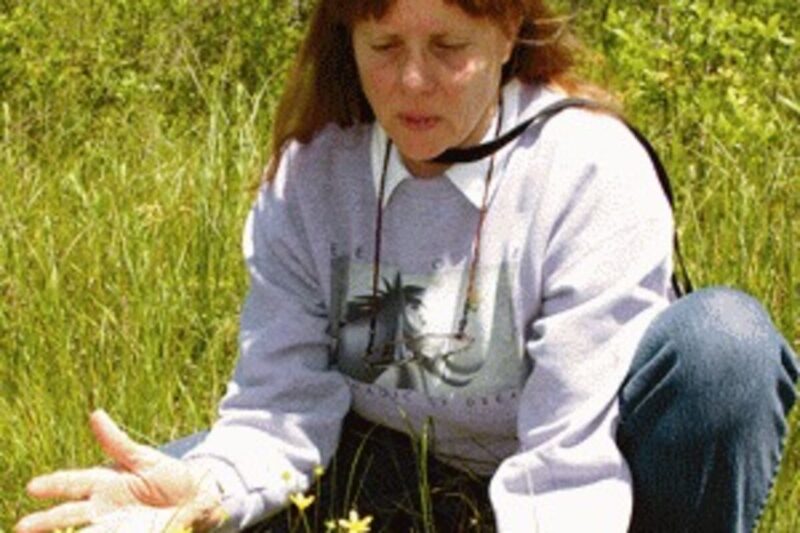Sean C. Morgan
Of The New Era
After several years of inactivity, the city of Sweet Home has gone to work to improve the Hobart Nature Preserve on the south end of 35th Avenue and is planning what to do with the park over the next few years.
The property includes extensive wetlands that contain an endangered wildflower, Bradshaw’s lomatium, a relative of the carrot. The park borders streets branching off 29th Avenue, Juniper, Foothills Drive and 35th Avenue in a “big ‘L’ shape.” It extends southward onto a hillside where it turns to a second-generation fir forest.
“You come out here in the winter, there’s creeks all over this thing,” Community Development Director Carol Lewis said. “What isn’t a creek is standing water.”
During the winter, tiny streams formed from old tire tracks that crisscross the park, resulting in the lomatium often growing right in shallow streams.
The lomatium bloom April to mid-May in the open prairie area of the park. The prairie is dotted with clumps of wetland woods, trees like ash, hawthorne and cottonwood, and covered with lomatium, camas and vetch.
The prairie is accessible and open to foot traffic only at the south end of 35th Avenue where the city is working on developing a gravel parking lot. From the parking lot visitors can enter the prairie. To the south is a wet wooded area just at the foot of a hill. As land rises, hardwoods give way to second-growth fir-type trees and thick woods, extending to the top of the ridge.
Lewis said she has walked most of the prairie area, but has not seen much of the forested hillside. Jim Wallace, parks maintenance man, has walked part of the hillside.
Much of it remains unexplored, Lewis said, except by the loggers who logged it last.
The city received the land as a donation about five years ago, Lewis said. During the winter, the city mowed some of the brambles, including invasive blackberries that were choking out the lomatium and the open prairie area in general.
Inmate crews worked on opening up the park land some more during the spring, she said.
“This is so cool,” she said, gesturing around the park. “This is what I work all the time to get my yard to look like – Not the blackberries though.
“I love this piece of ground. This piece of ground is beautiful. We’re very lucky to have something like this in the middle of the city.”
Right now, the city is focusing on clearing brush along park borders within about 50 feet from neighboring property lines, primarily for fire safety, she said. That includes some debris hidden in the grass.
Eventually, the area will be maintained annually by a habitat restoration company, Lewis said.
The Sweet Home Tree Commission is talking about building a sustainable forestry plan for the hillside, Lewis said.
The city has timber to manage now, and the Tree Commission would like to use “sustainable forestry practices” to do it.
Government agencies looked at the park last summer, Lewis said, and were excited by Bradshaw’s lomatium.
“The U.S. Fish and Wildlife Department was so excited when they were out here,” she said. “The botanist and Forest Service guy were in seventh heaven.”
The presence of the endangered flower could give Sweet Home access to federal grant dollars that Eugene often snaps up in the millions for habitat restoration projects, including presentation of the habitat to visitors.
“We also don’t want people stomping on the habitat,” Lewis said. She would like to build paths – boardwalk or gravel – throughout the park along with interpretive signage to explain what visitors are looking at.
The city will eventually put in benches and a few picnic tables.
Along the way, the city will need to develop a habitat restoration plan to explain how to maintain the park in coming years, Lewis said.
It will take the city many years to do everything in the park, Lewis said.
She does have money budgeted this year, she said. It will most likely be used finishing the looping driveway and parking area.
Senior Engineering Technician Joe Graybill already has the engineering for the parking area done, Lewis said.
In June, the city held its first summer recreation program at the park, with Sweet Home Ranger District Botanist Alice Smith and city Code Enforcement Officer Byron Wolfsong leading a hike to introduce people to the park.
Bradshaw’s lomatium, also called Bradshaw’s desert parsley, is a perennial native forb, ranging from 20 to 65 centimeters tall.
The leaves are similar to carrot plants. Both the leaves and bloom stalks extend from the base of the plant.
The bloom is yellow, clustered in compound umbels. The rays of the main umbel are usually of unequal length.
The plant blooms in April to mid-May and quickly goes to seed, while many plants within a population are sterile and never develop seeds.
The lomatium is endemic to the wet prairies of Western Oregon.
It is a federally listed endangered species that was once widespread in the wet prairies of the Willamette and Umpqua valleys.
Because of the conversion of its habitat to agricultural and industrial use, it is now limited to a few sites in Marion, Benton, Lane, Douglas and Linn counties.





